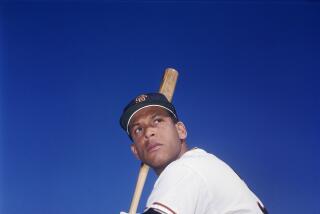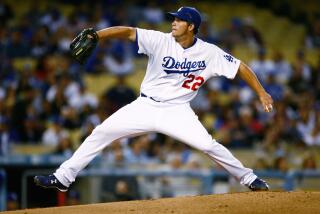He Beats the Bushes for Talent
Searching for those with attention-getting ability, or even those with only an occasional spark of it, in the rich baseball vineyards of California is a constant calling for Al Kubski.
His business card reads, âScout, Kansas City Royals.â He is more a realist than a dreamer, which is why he gets paid to be demandingly discriminating in the difficult process of charting talent.
Kubski, who lives in Carlsbad, Calif., is visiting his brothers in Baltimore and took time to relate varied experiences of seasons past and to destroy some long-accepted myths that have as much validity as old wivesâ tales.
His outdoor office, so to speak, is located in Southern California, an incubator for so many multi-talented players. The area has more scouts than any section of the country, with most major-league clubs having as many as four full-time men working the territory. Harry Dalton, general manager of the Milwaukee Brewers, said last year that 30 percent of the players in the American and National Leagues were born in California.
âItâs easy to understand,â remarked Kubski, âwhen you consider the state has a population of 13 million. Regularly scheduled amateur games go on from Jan. 7 until the following Dec. 15. When I began with Baltimore, in 1963, I covered from Fresno, south to the Mexican border and into the state of New Mexico. Now the scouting is more concentrated. Often, a scout can see three games a day. I probably averaged 10 games a week from March until June. Some of the colleges and high schools play at night, which makes it easier to crowd in a lot of games.â
Kubskiâs recommendations sent Bobby Grich and Doug DeCinces to the Baltimore Orioles before he joined Dalton with the California Angels, where he remained five years. John Schuerholz, general manager of the Kansas City Royals, hired Kubski 10 years ago.
Earlier, he managed 10 seasons in the minor leagues, most of the time for the St. Louis Cardinals and Pittsburgh Pirates, plus independent clubs in such places as Blackwell, Okla., in the Sooner State League, and Kilgore, Texas, in the East Texas League.
It has been an enjoyable life, but not an easy one. For 10 years, Kubski managed Christobal in the Panama Winter League and won nine pennants, using such players as Bobby Young, Lou Sleater, Tommy Lasorda, Don âTexâ Warfield, Bill Sweiger, Lou Grasmick, Clem Koshorek, Milt Graff and Spook Jacobs. With that kind of a background, plus experience as a player in the minors both before and after World War II, itâs reasonable to expect that Kubski knows a prospect when he sees one.
About Bo Jackson, the Royalsâ outfielder who also runs a football for the Los Angeles Raiders, he says, âHe has as much ability as anyone in baseball. He can throw, run and hit. He could have been another Mickey Mantle. Why, John Wathan, the manager, told me he saw him jump in the batting cage and take three swings left-handed. Two balls he hit went off the bank high up in right field at Kansas City.â
Kubski was managing Grand Forks in the Northern League in 1952 when he was attracted to a young shortstop with Eau Claire, a farm club of the then-Boston Braves. The kid player later moved to the outfield and, ultimately, Henry Aaron accounted for more home runs than Babe Ruth. Ah, the treasured gems that are filed away in the untapped storehouse of a scoutâs memory.
Itâs interesting to hear Kubskiâs views, based on almost 50 years in the game. He says it is indeed possible, although rare, for youngsters to improve physical skills such as throwing, running and hitting. Some of his most notable examples:
Tom Seaver: âI saw him, if you can believe it, when he had a below-average fastball. The Dodgers were only going to offer him $12,000. Some clubs wouldnât give him over $4,000. But he pitched against a team called the Crosby All-Stars one winter and was facing a lot of active major-leaguers. He struck out 12 in five innings. Milwaukee had his draft rights and was trying to sign him but it was ruled illegal and the commissioner declared Tom a free agent. The Mets got Seaver and signed him for $50,000. I found out then that, yes, after 18 a fastball can be improved. Itâs unusual but it can happen, as I saw with Seaver.â
George Brett: âWhen I first worked him out, he held his bat real high. He didnât show much power. But he was a competitor. Lou Pinella convinced him he could drive the ball with authority rather than just hit line drives. And then Charlie Lau, the batting coach, showed him how to get the barrel of the bat out front. Heâs headed for the Hall of Fame.â
Bob Skinner: âI never thought a playerâs running speed could increase, yet it happened with Bob. He was a poor runner. But a track coach got him along the way and showed him how to lengthen his stride. He was an excellent hitter, with good power. The surprising thing is he improved his running. I think about that every time someone says itâs impossible to help an athlete run faster. You can learn to run better, the same as you can improve as a fielder.â
Dave May: âI was managing Kingsport in the Appalachian League when I saw Dave May. He was at Salem, Va., and was a great young hitter. But he had one of the worst arms I ever saw in organized baseball. A poor arm is rated a No. 2. He wasnât even a No. 2. The Orioles drafted him and he kept hitting, but he couldnât throw. I remember once in the minor-league camp when Jim Frey took him to center field, about 300 feet from home plate, and showed him how to get more of his lower body and back into the throws. But the best he could do was get the ball to roll to the pitcherâs mound. Then his arm came around. He told me he went into his cellar at home in the winter and threw against a wall. His shoulder pained but he kept it up. Finally, something loosened and he had an above-average big league arm. I couldnât believe it but, again, I saw a baseball miracle.â
Willie Stargell: âHe was a 165-pound rookie when I was his first manager at Roswell, N.M., in 1959 and he had it tough. A black player who couldnât stay with us or eat with us. It was difficult. But we talked a lot and I told him what he was having to endure would make him a stronger person and even a better player. He hit seven home runs, all over the left field fence. But as he got heavier, he showed more power and began to pull pitches instead of hitting to the opposite field. He said in his book I helped him and Iâm pleased at that.â
As for hard throwers, Kubski pre-dates the radar gun. He said the highest clockings he ever saw were Nolan Ryan and Rich Gossage at 94 mph. âItâs amazing how few pitchers ever get to 85 on the gun,â he comments. âRight now there are only three college pitchers I know of who can go over 85. So the way a pitcher throws is frequently exaggerated.â
He, remembers, too, when he played in a Cardinals system that had 29 farm clubs. That was the era of chain-store baseball and a time when virtually every youngster in America wanted to be in baseball. Kubski also has seen all the other sports offer high financial rewards, which means baseball has lost out to some degree to pro football, basketball, golf and tennis.
But Al Kubskiâs objective never changes -- to find players who can fulfill the ultimate ambition he holds for all of them. Itâs the major leagues, where so many are called and a mere handful chosen.
More to Read
Go beyond the scoreboard
Get the latest on L.A.'s teams in the daily Sports Report newsletter.
You may occasionally receive promotional content from the Los Angeles Times.










